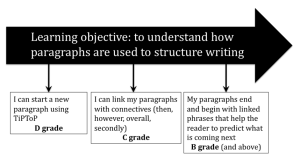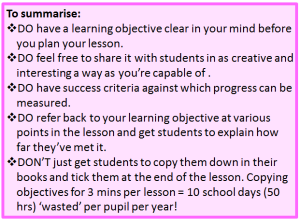I came across this very interesting blog post by David Didau where he explains how he sets learning objectives as a “journey” (or what he calls the “Learning Continuum”) so that students can achieve outcomes at different levels. He writes the objective within an arrow to represent the progress and direction of the learning, which in other words means “this knowledge is going somewhere; this skill can be developed to different levels of expertise”.
I thought this made a lot of sense and was a simple and very visual way to differentiate objectives whilst allowing students to make progress without suggesting a point at which they can opt out (as opposed to the all/most/some approach which, according to him, is a “recipe for low expectations”).


To take this even further, what about putting the objectives with empty boxes on laminated sheets so that the students can plan their own differentiated criteria? Or the boxes filled in but the objective blank?
If you are struggling for ideas on how to introduce learning objectives in a meaningful way, what about trying one of these? They will undoubtedly get students talking and thinking not only about what they are learning but also why they are learning it… (ideas taken from David Didau’s excellent The Learning Spy blog).
1. Expand a sentence
Start the objective and ask students to add “because” and come up with reasons (For example “Proofreading and redrafting will improve your writing because…”) or to add so that in order to communicate the relevance of learning.
2. Connected Words
Give tables/pupils different key words to focus on (from the learning objective) and ask them to come up with as many connected words as possible in 1 minute.
3. Missing Keyword
Leave a blank in your learning objective for pupils to fill in. (For example “to be able to use success criteria to _ _ _ _ _ _ _ your work”.)
4. Odd One Out
The odd one out techniques suggests showing the class 4 statements or objectives and then getting them to work out what the actual objective is. (In this case which of the following statements they thought would make the most impact on the quality of their work.)
– You should make your work as neat as possible
– You should count the exact number of words you have written
– You should read through your work and check you have met all the success criteria
– You should use the time to do a bit more writing
5. Order the learning
The basic premise of this one is to take out the words of the objective and arrange them in order of importance.


If you want to read more on the subject, check the following posts:
http://learningspy.co.uk/2012/02/18/learning-objectives-why-we-need-em/
http://learningspy.co.uk/2011/07/11/using-learning-continuums/
http://learningspy.co.uk/2011/10/09/40-ways-to-introduce-learning-objectives/



